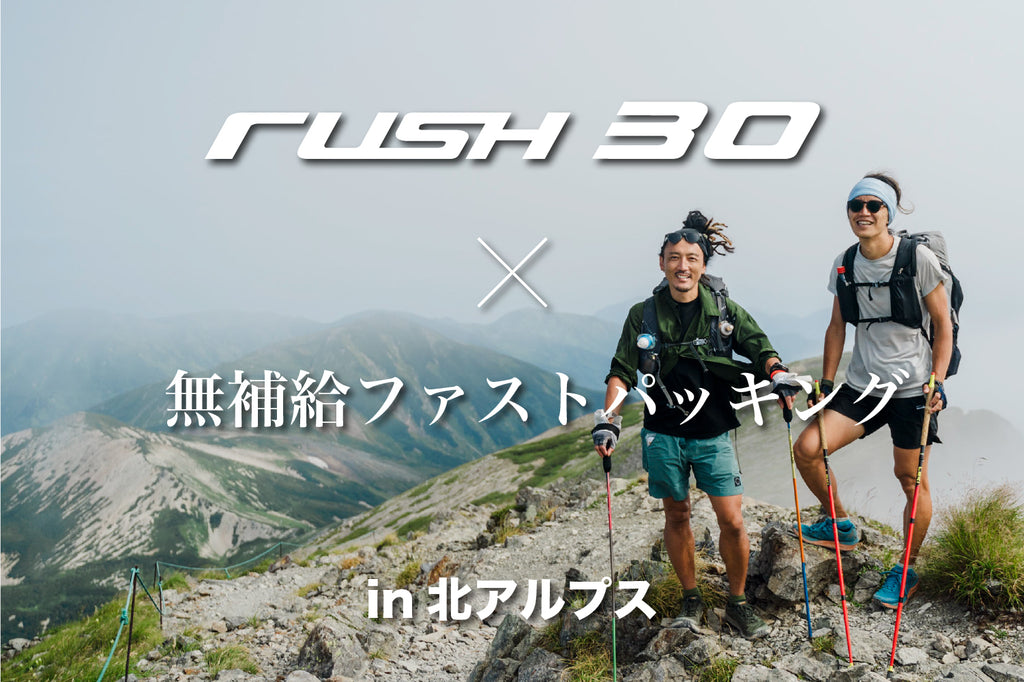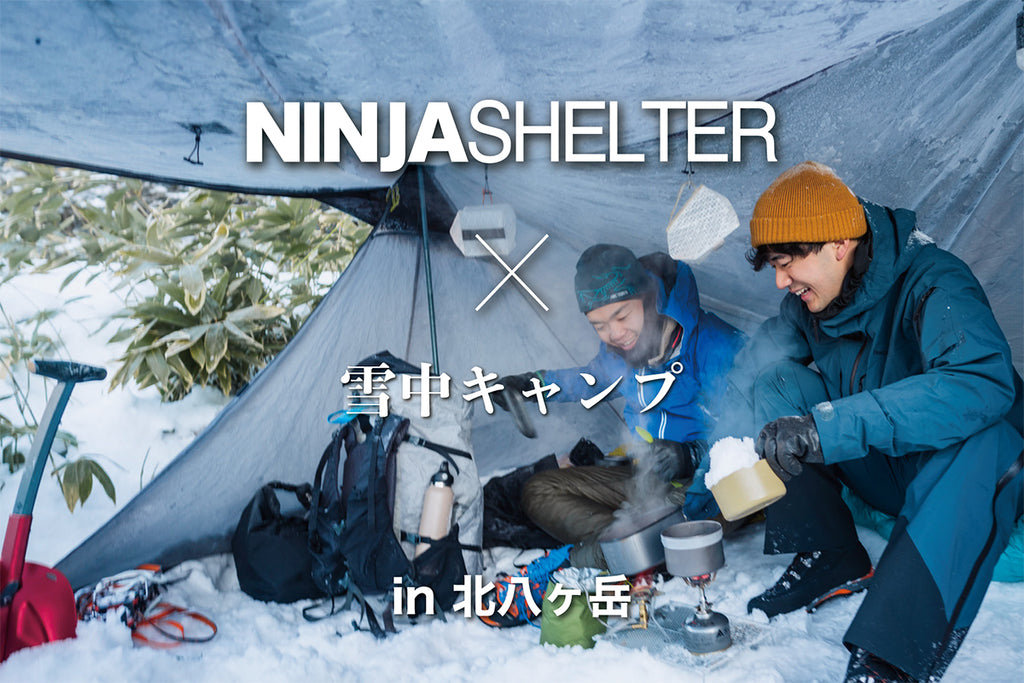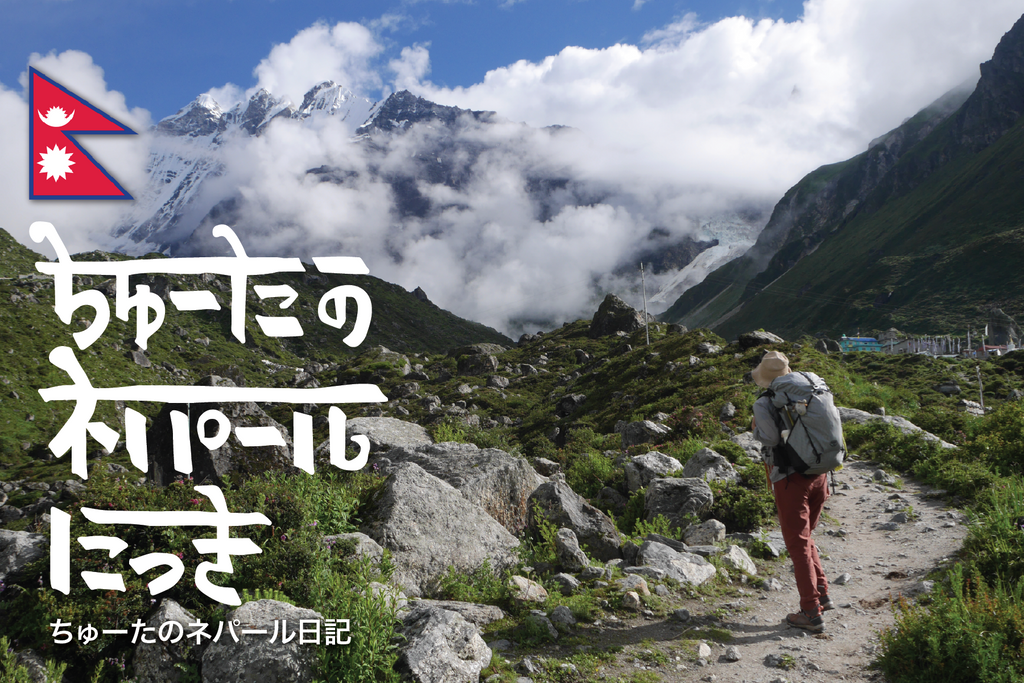MAGAZINE

RUSH30 × 無補給ファストパッキング in 北アルプス

The Rush Series backpack, developed specifically for trail runners, takes center stage. Among them, the RUSH 30 stands out with the capacity and features suited for fast packing trips that include camping, offering a remarkable stability even during dynamic movement.
To further explore the possibilities of the RUSH 30, an ambitious project was launched: running from sea level to nearly 3,000 m in the Alps—and camping along the way. Tackling what could be considered a wildly audacious endeavor were two PAAGO Friends trail runners.
First, Takuya Wakaoka, who has continually taken on overseas stage races and completed a successful traverse of Japan from Hokkaido to Kyushu last year. Second, Hideki Fujikawa, a hairdresser who, alongside his profession, competes in long-distance races and leads the running team “Chicken Heart.” Together, they ascended from Oya-shirazu on the Sea of Japan, traversed the Tsugaikai Shindō, and raced across the ridgelines of the Northern Alps.
This project emphasized testing the capabilities of the RUSH 30 under conditions such as “camping gear only” and “no resupply except water.” In addition to the shooting crew, ground staff monitored weather and mountain huts. Utilizing the full force of the PAAGO Works team, this massive cross-Alps venture marked a fitting culmination of summer 2024.
Team Introductions
Takuya Wakaoka(left) – An ultra-distance trail runner and PAAGO Works ambassador. After placing in Brazil's Amazon Jungle Marathon in 2014, he went on to compete in long-distance races across extreme environments—mountains, deserts, snowfields—thriving in every terrain. In 2023, he undertook the “Japanese Archipelago Longitudinal Traverse.
Hideki Fujikawa(right) – Owner of Broccoli Playhair, a hair salon in Ebisu. Although he began running to lose weight, over 10 years he has grown into a trail racer in both domestic and international events. He leads the running team “Chicken Heart,” hosts trail running events in Hakone, and actively engages in trail maintenance and etiquette education.
Route Overview: Oya-shirazu → Tsugaikai Shindō → Hakuba → Mount Karamatsu


The project spanned four days. On Day 0, they traveled from Tokyo to Oya-shirazu, preparing their packs at a lodge in anticipation of the next morning’s start. On Day 1, they climbed Tsugaikai Shindō to reach Asahi Hut—about 28 km with 3,600 m of cumulative ascent—in blistering summer heat, posing a high risk of dehydration and heatstroke.
Day 2 led via Yukikura Peak toward Hakuba, crossing both gentle folds and steep peaks in a highlight-rich section. On Day 3, depending on pace and weather, they devised flexible descent plans—possibly via Mount Karamatsu or Mount Goryu, or down to Ōgisawa—to adapt as needed.
Normally, the route from Oya-shirazu to Karamatsu would require 3 to 5 nights. This team effectively condensed it into just two. Their combined strength and the RUSH 30’s agility made this daring plan possible.
The filming approach was unconventional. No single PAAGO crew member could keep pace with both runners under these conditions (or even surpass them). So, two shooters were assigned, and for sections, the runners themselves also handled filming. Meanwhile, ground staff in Kōkubuji coordinated the camera crew’s rendezvous points. On Day 1, Knōr, the youngest PAAGO crew member, filmed from Oya-shirazu to Asahi Hut. Early on Day 2, Wakaoka and Fujikawa filmed themselves. Afterward, cameraman Kobayashi took over, joining them en route as directed by the ground staff. It was ultimately an all-hands-on-deck effort—an extraordinary challenge even by PAAGO’s standards.
Day 1: Climb from Sea Level into the Scorching Forest!
At 4 a.m., Wakaoka and Fujikawa stood at the coast of the Sea of Japan. With the sound of waves behind them, they stepped onto the trail. PAAGO staff member Knorr trailed close to capture their ascent.





That day’s path climbed from sea level to Mount Asahi (2,417 m) before reaching the Asahi Hut campground—traversing dense alpine forest, highland bogs, and breathtaking ridgelines of the Northern Alps. They started before dawn, a mix of fear and exhilaration in their hearts as they said farewell to the sea.
Two hours in, the heat and humidity exceeded expectations. At a high pace—half the standard course time—Knōr had to call timeout. Yet Wakaoka and Fujikawa appeared unfazed, even smiling at him. It was mystifying—almost infuriating—until he realized it was their way of encouraging him. Their ease and excitement about what lay ahead gave him the determination to press on.
(By the way, Knōr himself had been on his high school alpine team and competed in adventure racing in college. His strength, experience, and youth gave hope that he could hang with these two.)
The Trail of Dreams: Tsugaikai Shindō
Tsugaikai Shindō began with one man’s dream: to link the ridges of the Northern Alps. In 1961, Ken Ono formed the Sawagani Mountaineering Club and began building the route in 1966. After six arduous years, it became the first fully continuous traverse in the region—allowing vertical observation of plant zones from sea level to nearly 3,000 m, alongside Permian-to-Mesozoic rocks. It remains the only trail in Japan offering such a geological and botanical cross-section, and is prized for its diverse flora and sweeping alpine vistas.



Along the ridgeline, fatigue overtook the author. Only at a minor summit near the mountain hut did cell signal return—and ground staff checked in. Overwhelmed, the author admitted, “I want to quit.” But the team, knowing him too well, half-threatened, half-encouraged him on. Their firm support kept him going.

結局、このあとの黒岩山のピークまでついていき、チームを分散することになった。




Wakaoka and Fujikawa pressed on to reach Asahi Hut in 12 hours. The author took over 13 hours. Exhausted beyond belief, he arrived to find them still smiling. Fujikawa had already checked in with the staff and arranged lodging. They shared a meal and slept in preparation for the next day.


Fujikawa’s Voice: “Leaving the lodge before dawn, touching the sea to start before sunrise, I didn’t expect how hot it would get—or how much I’d sweat. Walking pace made me forget salt supplements, but seeing my sweat falling fast, I asked Wakaoka for some. I also munched on salty rice crackers I brought. Water points were few or dried up, so we carried 1.5 L each, taking turns fetching and purifying water with my filter. That turned out to be a lifesaver. To avoid arriving at the hut too late, I went up the final slope with Wakaoka—knowing Knōr would descend with a Patagonia crew friend.”
Wakaoka’s Voice: “Everything was unexpected—even whether we could go, given a typhoon. We aimed for half the standard pace, carrying heavier gear for hiking without resupply—but the total was still only around 11 kg: lighter than I feared. I thought we could easily hike—or even run. But Knōr nearly collapsed just three hours in, which wrecked the schedule. I was exasperated, but he’s only 21—so I coaxed him up. It changed plans, but maybe it made the trip all the more meaningful.”
Day 2: Racing Through the Hakuba Mountains
They rose at 4 a.m., broke camp, and departed before daylight to gain distance early. Knōr descended to retrieve the vehicle and rejoin on Day 3. From then on, only Wakaoka and Fujikawa ventured forward.


As dawn broke, they prepared meticulously—mindful that water supply lay only ahead at huts. With light, fast steps that belied the previous day’s exhaustion, they powered on.


Fujikawa’s Voice: “We’d decided to eat breakfast in Hakuba, while drying out drenched clothes. Gone were the humid, sweaty conditions—the crisp air and alpine ridge views were refreshing. Before I knew it, we were at Hakuba. When I saw Kobayashi waiting with a camera, I was elated.”
Wakaoka’s Voice: “I’m not a morning person, so it was steady going. But on the way up to Hakuba-dake, a woman saw Fujikawa’s dreadlocks and said, ‘MISIA, MISIA!’ I was puzzled, but realized she was referencing the singer MISIA’s hair. It snapped me awake—I laughed and instantly felt alive.”
Under the Summit of Hakuba-dake
Kobayashi had joined via Tsugaike, catching sunrise and arranging a rendezvous. He awaited near the summit—camera ready—until they emerged from below the ridgeline’s fog.








Coordinating with no fixed schedule, the shooting plan hinged on pace and weather. Based on expected timings, they aimed to metamgate from Mikuni-kyō to Hakuba-dake between 8–9 a.m. Testing that guess on the trajectory.
Wakaoka and Fujikawa ran strong—until Wakaoka, having skipped breakfast, grumbled about hunger. They stopped at the summit lodge’s table, roughly 4–5 hours after departure. A well-timed rest.
From there, a runnable route led toward Hakuba-Yarigatake: gentle ups and downs, ever-changing vistas, quiet paths even in peak season.







What stood out was their composure. They moved at roughly 0.6× normal pace, chatting even on steep climbs—finding no breathlessness even when filming. And I’m sure, without the camera crew, they’d have gone faster.
They reached Tengu Sanso at noon—time to decide whether to push on or wait, especially with rain forecast and a notorious stretch ahead: the “Kaerazu-no-Ken.”
Kaerazu-no-Ken (“The Unreturned Sword”) isn’t a marked trail. It requires scrambling and chain sections—not pure run nor hike. Rain would make it hazardous. Still, they decided: “Let’s attempt to move forward, and retreat if it starts to rain.”





Support from Ground Staff:
With no fixed campsites, ground staff monitored the runners constantly and communicated location to the film crew. As weather forecasts fluctuated, they made decisions dynamically, sharing updates as conditions evolved.
Ground Staff’s Comment:
“Weather is always a factor in location shoots—but if it changes with every check, it’s maddening. And, even on exposed ridgelines with incredible views, phone signal was spotty. IBUKI was a lifesaver—tracking them when we couldn’t reach them. Yet they moved so fast they’d disappear from the map! And despite such a brutal trail, all the photos they sent were smiling faces—so unexpected! We had to set camera-team rendezvous just six hours in advance—my phone’s camera roll is full of weather app screenshots.”

IBUKIの電波が絶好調で、連絡が取れなくても居場所はわかる。でもちょっと目を離すとふたりはあっというまに進んでいる(これは本当に想定外!)。しかも2人にひいひい言わせるルートのはずなのに、たまに送られてくる写真が全部笑顔(これも想定外!)。ふたりのスピード×天気=距離を予測しつつ、カメラマンの合流ポイントを決めなければならない。白馬大池か白馬大雪渓か唐松岳か……。結局決まったのは合流6時間前のことだった(スマホのカメラロールはお天気アプリのスクショで埋め尽くされた)。





As they descended Tengu’s steep slope, Kaerazu-no-Ken and formidable Karamatsu-dake loomed ahead. Terrain shifted: poles packed, speed throttled for safety. Favorable weather made passage doable, and they could reach Karamatsu-dake’s campsite by around 4 p.m., given smooth progress.
They cleared Kaerazu-no-Ken without incident, summited Karamatsu-dake just after 3 p.m., and paused to gaze back at their traversed ridgeline—its serene, dramatic contours revealed through cloud breaks.
I realized that navigating that terrain in standard multi-day hiking gear would be grueling. But the RUSH 30’s compactness and lightweight packing preserved their endurance and motivation to press forward.








無事に不帰の嶮を通過し、15時すぎに唐松岳山頂に到達。振り返ってみると、歩いてきた稜線が雲の合間から姿を見せた。白馬岳周辺のゆるやかな稜線とは異なり、緊張感のある岩場がつづくセクションを越え、ほっと一息。テント場で目まぐるしく過ぎていった一日を振り返るのだった。
このとき感じていたのは、一般的な縦走登山の装備で、不帰の嶮の難所を通過するのはとても大変だということ。ときにはオーバーハングした岩場を、ある程度のスピード感をキープしながら通過できたのは、パッキングが小さく軽量だったからだ。また、重装備では長距離の歩行で体力を消耗し、唐松岳まで行こうというモチベーションがなくなっていたかもしれない。
Fujikawa’s Voice: “The afternoon forecast looked dicey. With spotty signal, we kept messaging ground staff about when to expect rain. We considered aborting the Kaezu section if wind and rain picked up—I wasn’t gonna lie, I was freaking out! But the weather held, the rock was dry, and we swept through quickly. And the Karamatsu campsite felt like a private cabin—what a comfort!”
Wakaoka’s Voice: “Mountain weather is like teenage crushes—unstable but steady. Capricious, yet not entirely directionless. We were covered in fog, but not drenched—the rain threatened but never came. Grateful for that. Mountains and love: both can hurt, but a little edge makes it interesting. Kaezu-no-Ken felt like a rugged playground. Had it been damp, it would’ve been far harder. So we were lucky with the weather.”
Day 3: Descending from Karamatsu-dake
Given the forecasted bad weather the prior night, they decided to end the traverse at Karamatsu-dake. They enjoyed a leisurely breakfast, packed for descent—and were greeted by blue skies that tempted them onward. Yet trusting the forecast, they headed down the Happo-One trailhead.







From there they overlooked the ridgelines they’d traversed—reflecting on the journey. Though only two active days, they covered more than 50 km, climbing renowned peaks. The trip condensed unforgettable alpine landscapes into a powerful short expedition.
The core question: Is it possible to do a tent-camping traverse with the RUSH 30? Already used in rogaining events for overnight kit and food, it proved reliable and stable. The last decade’s gear miniaturization means overnight treks are feasible even with a 30 L pack—common among ultralight hikers.
What sets the RUSH 30 apart is stability: high center-of-gravity design, snug harness, and well‑placed pockets. Few trail-running packs in its class offer 30 L capacity.
For hikers, it opens up faster, more active trips; for runners, it enables longer runs by adding self‑supported camping. It’s a pack both groups should try.
Fujikawa’s Voice: “Rescheduling from July had made this leg hard to slot in. The weather was so iffy that up until the last minute, ground staff wrestled with whether to go or not. I’m so grateful they decided to move forward. Doing it with a team—camera rendezvous, ground staff coordination, pick‑ups—felt different from going solo. It was fresh and fun.
Despite long distances and races, I'd had little experience with alpine ridge traverses, technical sections, or tent camping at altitude, so I was anxious. Talking gear selection, packing into the RUSH 30, layering and equipment with Wakaoka—I learned so much. Maybe in two years, my son and I can do this together. This experience encouraged me to venture deeper into the mountains.”
Wakaoka’s Voice: “I’d just done an ultra-race in Mongolia in late June—with week-long grassland camping. And last summer’s longitudinal Japan traverse. In retrospect, those were extreme camping. Doing a ‘normal’ backpacking traverse felt good. I laughed and chatted with Hideki, we ate, we slept—three full days. Despite us staggering around, we pulled it off—Knōr, Kobayashi, ground staff and all. Doing it with others gave it fresh energy. Solo is fun—but with friends, you can go much farther.”
PAAGO Works Knorr’s Voice: “After descending to Oya-shirazu, my task was to pick up the runners and cameraman—not just to meet them, but to meet them while tackling a reverse portion of the route. At dawn, I headed to Happo‑ike, thinking they’d arrive there exhausted—but instead, two smiling faces waited. I realized anew how tough they really are.”
Bonus:
Before the journey, they had kick-off gear talks and pack‑fitting sessions over a group chat. As keen readers may notice, Wakaoka carried a developmental 30 L prototype—part field test, part gear review.
They carried one tent—NINJA TENT—and split the gear, with Wakaoka bearing much of the load.





グループチャットでの打ち合わせやギアについての議論を交わしつつ、実際にパッキングとフィッティングを行った。なお、記事を読んで気づいた方もいると思うが、若岡が背負っていたバックパックは、現在開発中の30Lのバックパック。発売前のフィールドテストも兼ね、その機能性をテストしていたのだった。
ちなみに、テントについては、それぞれが携行するパッキングを行っていたが、最終的に2人でNINJA TENT1張りに。若岡が背負う形で装備を分担した。
Gear List:
Fujikawa


Wakaoka


RUSH 30

A fast‑packing model built for “run‑and‑camp.” Designed for overnight fast packing with a high‑center‑of‑gravity structure and unique top stabilizer, it delivers ideal balance and comfort. Despite the challenging traverse, it proved suitable for multi‑night treks. With fewer exterior pockets, water bottles, fuel, smartphone, and power bank can fit in harness pockets—making this pack a nimble companion for kinetic alpine traverses.









